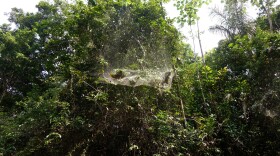Glenn Marangelo
Host of Bug Bytes-
If you suffer from arachnophobia (the fear of spiders), then hold onto your seat. While the thought of one spider might be terrifying, what about spiders that hunt in packs of hundreds?
-
The roaches are messy eaters, leaving bits of foo on their heads. The mites are like a tiny cleaning crew that eats any scraps of food left on the roach’s face.
-
Most Hairstreak Butterflies have hair-like tails looking like a pair of antennae and the colored marks looking like eyes. It appears that the butterfly has two heads!
-
Ouch, that really hurts! But in comparison to the sting of other insects, how much does it really hurt?
-
These six-legged architects regulate the mound’s internal temperature by opening and closing heating and cooling vents they constructed throughout their home, enabling them to adjust air currents to keep their insect skyscraper at the ideal temperature.
-
Instead of slipping on a cloak, two species of moths rely on the unique shape of the scales that cover their wings to go undetected by bats.
-
Introducing, the Harvester Butterfly …the only species of butterfly in North America where the caterpillars eat meat. More specifically, Woolly aphids are on their limited menu.
-
While other beetles are known to make various squeaks and hisses, Bess Beetle adults and larvae can make 14 distinctly different sounds to convey danger to the rest of the family, attract a mate, and enable family communications.
-
Lemon Ants prefer to build their homes in the stems of the tree species that survive in Devil’s Gardens. As it turns out, this is not a coincidence. In the eyes of a Lemon Ant, other trees not suitable for housing their kin just get in the way and take up valuable real estate. To make their surroundings more suitable for the continued existence and growth of their colony, it’s the Lemon Ants that rub out any rival vegetation.
-
The aphids survive winter in the egg stage and emerge with the return of warmer weather. Surprisingly, all of the hatching eggs produce females. So, with no males in the population, the ladies employ a different reproductive strategy.











